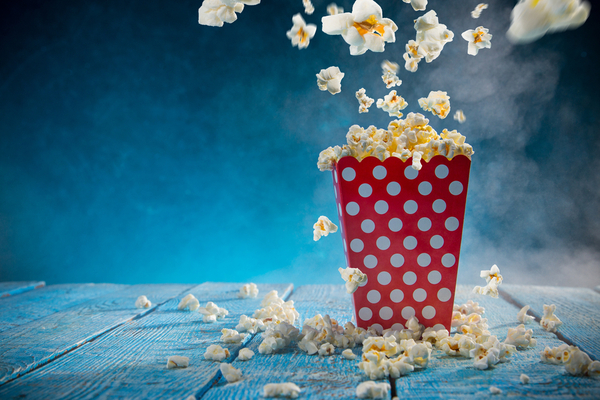National Popcorn Day is a day that celebrates one of America’s favorite snack foods, popcorn. While there is some debate on the origins of this day and on which day it should be celebrated, most popcorn aficionados agree that the day is usually celebrated on January 19th.
The origins of this holiday is currently unknown, but many people believe that it started because of the Super Bowl. Which seems like a fairly logical conclusion, and why so many disagree on the actual Popcorn Day – if it fell on Superbowl Sunday, it would naturally change year after year. And after all, millions of Americans watch the Super Bowl with great big buckets of buttered popcorn at their fingertips.
Here are some great Popcorn fun facts and history, courtesy the Popcorn Board (yes, that’s really a thing):
Americans consumer around 16-17 billion quarts of popcorn each and every year. That’s over 52 quarts for each and every man, woman and child in the country per year. And this number continues to grow by about 5 percent each year. This makes it one of the most popular snacks in the United States.
About two-thirds of the popcorn consumed in the United States is consumed in the home. The other third is served at theaters and sporting events.
Popcorn dates back thousands of years. Biblical accounts of “corn” stored in the pyramids of Egypt are misunderstood. The “corn” from the bible was probably barley. The mistake comes from a changed use of the word “corn,” which used to signify the most-used grain of a specific place. In England, “corn” was wheat, and in Scotland and Ireland the word referred to oats. Since maize was the common American “corn,” it took that name — and keeps it today.
It is believed that the first use of wild and early cultivated corn was popping. The oldest ears of popcorn ever found were discovered in the Bat Cave of west central New Mexico in 1948 and 1950. Ranging from smaller than a penny to about 2 inches, the oldest Bat Cave ears are about 4,000 years old.
Popcorn was integral to early 16th century Aztec Indian ceremonies. Bernardino de Sahagun writes: “And also a number of young women danced, having so vowed, a popcorn dance. As thick as tassels of maize were their popcorn garlands. And these they placed upon (the girls’) heads.” In 1519, Cortes got his first sight of popcorn when he invaded Mexico and came into contact with the Aztecs. Popcorn was an important food for the Aztec Indians, who also used popcorn as decoration for ceremonial headdresses, necklaces and ornaments on statues of their gods, including Tlaloc, the god of rain and fertility.
Writing of Peruvian Indians in 1650, the Spaniard Cobo says, “They toast a certain kind of corn until it bursts. They call it pisancalla, and they use it as a confection.” And in South America, kernels of popcorn found in burial grounds in the coastal deserts of North Chile were so well preserved they would still pop even though they were 1,000 years old.
Although popcorn is typically thought of as a snack food today, popcorn was once a popular breakfast food. Ahead of its time and very likely a role model for breakfast cereals to come, during the late nineteenth and early twentieth centuries, popcorn was eaten just as we eat cereal today. In fact, long before the advent of the corn flake, Ella Kellogg enjoyed her popcorn ground with milk or cream. Although she discouraged in-between meal snacking, she urged others to eat popcorn at meals as popcorn was “an excellent food.” Ella understood, as her husband did, that popcorn was a whole- grain. John Harvey Kellogg praised popcorn as being “easily digestible and to the highest degree wholesome, presenting the grain in its entirety, and hence superior to many denatured breakfast foods which are found in the market.”
In the late nineteenth and early twentieth centuries, popcorn balls were one of the most popular confections and often given as gifts. Their popularity spawned an industry of popcorn ball making gadgets. Victorian families often decorated fireplace mantels, doorways and Christmas trees with ornate ornaments made from popcorn balls. And by the turn of the century, most cookbooks featured at least one recipe.
The “talking picture” solidified the presence of movie theaters in the U.S. in the late 1920’s. Many theatre owners refused to sell popcorn in their theaters because they felt it was too messy. Industrious vendors set up popcorn poppers or rented storefront space next to theatres and sold popcorn to patrons on their way into the theatre. Eventually, theatre owners began installing popcorn poppers inside their theatres; those who refused to sell popcorn quickly went out of business.
Popcorn went into a slump during the early 1950s, when television became popular. Attendance at movie theaters dropped and with it, popcorn consumption. When the public began eating popcorn at home, the new relationship between television and popcorn led to a resurgence in popularity.
Percy Spencer, Raytheon Manufacturing Corporation, figured out how to mass-produce magnetrons which were being used to generate microwaves for use in World War II. Looking for post-war applications of Raytheon technology, Spencer spurred the development of the microwave oven in 1946. Popcorn was key to many of Spencer’s experiments. Microwave popcorn was available for the marketplace in the early 1980s, and today, popping popcorn is one of the number one uses for microwave ovens. Most microwave ovens have a “popcorn” control button.
So, how should you celebrate National Popcorn Day? Maybe do a popcorn dance, don a popcorn necklace, make yourself a popcorn ball, grab some kettlecorn from your favorite farmer’s market vendor, go to the movies and eat your way through the flick, or heck, just stay home and pop some up in the microwave. The world’s your popcorn kernel.
—
Photo Credit: Lukas Godja / Shutterstock.com
